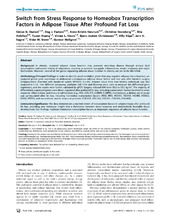Switch from stress response to homeobox transcription factors in Adipose tissue after profound fat loss
Dankel, Simon N; Fadnes, Dag J.; Stavrum, Anne-Kristin; Stansberg, Christine; Holdhus, Rita; Hoang, Tuyen Thi Van; Veum, Vivian L.; Christensen, Bjørn Jostein; Våge, Villy; Sagen, Jørn V.; Steen, Vidar Martin; Mellgren, Gunnar
Peer reviewed, Journal article
Published version

View/
Date
2010-06-09Metadata
Show full item recordCollections
Original version
https://doi.org/10.1371/journal.pone.0011033Abstract
Background In obesity, impaired adipose tissue function may promote secondary disease through ectopic lipid accumulation and excess release of adipokines, resulting in systemic low-grade inflammation, insulin resistance and organ dysfunction. However, several of the genes regulating adipose tissue function in obesity are yet to be identified. Methodology/Principal Findings In order to identify novel candidate genes that may regulate adipose tissue function, we analyzed global gene expression in abdominal subcutaneous adipose tissue before and one year after bariatric surgery (biliopancreatic diversion with duodenal switch, BPD/DS) (n = 16). Adipose tissue from lean healthy individuals was also analyzed (n = 13). Two different microarray platforms (AB 1700 and Illumina) were used to measure the differential gene expression, and the results were further validated by qPCR. Surgery reduced BMI from 53.3 to 33.1 kg/m2. The majority of differentially expressed genes were down-regulated after profound fat loss, including transcription factors involved in stress response, inflammation, and immune cell function (e.g., FOS, JUN, ETS, C/EBPB, C/EBPD). Interestingly, a distinct set of genes was up-regulated after fat loss, including homeobox transcription factors (IRX3, IRX5, HOXA5, HOXA9, HOXB5, HOXC6, EMX2, PRRX1) and extracellular matrix structural proteins (COL1A1, COL1A2, COL3A1, COL5A1, COL6A3). Conclusions/Significance The data demonstrate a marked switch of transcription factors in adipose tissue after profound fat loss, providing new molecular insight into a dichotomy between stress response and metabolically favorable tissue development. Our findings implicate homeobox transcription factors as important regulators of adipose tissue function.
Publisher
Public Library of ScienceCopyright
Copyright 2010 Dankel et al.Dankel et al.
